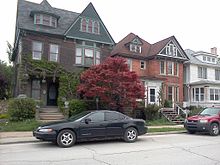This is an old revision of this page, as edited by Detroit Joseph (talk | contribs) at 00:07, 13 November 2013. The present address (URL) is a permanent link to this revision, which may differ significantly from the current revision.
Revision as of 00:07, 13 November 2013 by Detroit Joseph (talk | contribs)(diff) ← Previous revision | Latest revision (diff) | Newer revision → (diff)
Hubbard Farms is a neighborhood and historic district in southwest Detroit. It is located on one of the old plots which used to be a ribbon farm along the Detroit River. Currently home to a large number of Detroit's Latin American immigrants, this district has gone through many changes in its history. In 1993 this district received its official historic district designation. It is bounded by Clark St to the west, W Vernor Hwy to the north, W Grand Blvd to the east, and W Lafayette Blvd to the south.
History
Dating back in use to times before French fur traders even colonized the Detroit area, this district was in use by the Pottawatomie tribes. The Hubbard Farms district was originally a burial ground for the local Pottawatomie tribes. After the area was eventually colonized by the French in the 1700s, the land was granted to Robert Navarre, the royal notary at Fort Ponchartrain, who then split the land tract into five ribbon farms along the Detroit River.
After the end of the war of 1812 many of the English immigrants in the area began to buy up land and establish smaller farms. One of the first U.S. citizens to own land in the area was Whitmore Knagg, a military interpreter and frontier Indian fighter. Some of the land he purchased included the Hubbard Farms Historic District. In 1835 this land was sold to the Hubbard Family.
Bela Hubbard, a prominent local geologist and realtor, is the man for whom the district is actually named. In the 1830s, Bela was doing some surveying and realized that the area had once been a Pottawatomie village and burial ground. Upon excavating the site, he found many Indian artifacts. When the state of Michigan was founded in 1837, Bela was named Michigan's first assistant geologist.
Once the Civil War came to an end, Detroit experienced an influx of manufacturing jobs and housing was needed for the many executives and workers who poured into the city. This district soon became home to David Scotten, the owner of the Hiawatha Tobacco Works factory, which was established in the area. Finally in 1885 the district became part of Detroit proper.
Much of the architecture in the area was designed and built in the period between the 1880s and the First World War giving it a very Victorian feel. The district is not limited to this as many of the people settling the area had enough money to build whatever they wanted. As a result, you can find homes that display Romanesque, Colonial Revival, Beaux Arts, or even Italianate designs.
Points of interest
There are many places and organizations of note in this district that give the district many unique flavors.

Clark Park - Currently managed by the Clark Park Coalition, the park serves as the district’s “town square,” hosting festivals, fairs, sporting events and extracurricular activities for the youth in the community. The coalition emerged in 1991 as the community’s response to the closing of the park by the Detroit Recreational Department.

Armando’s Mexican Restaurant - Located on the northern edge of the neighborhood is Armando's Mexican Restaurant. This is a very popular restaurant in the area which caters to the American public interested in getting a little taste of Latin America and draws in many visitors from surrounding neighborhoods and nearby cities.

Mexican Town Bakery - This bakery offers traditional Mexican pastries which are not easily found elsewhere in Michigan.

Cafe Con Leche - “Cafe con leche” literally translates as “Coffee with milk.” This is apparently the only cafe left in the southwest Detroit area.

Maybury Elementary School - Located across the street from Clark Park this school has a very perceptible style of architecture, and its white brick stands out from the surrounding homes. Just like its counterparts, Western International High School and Earhart Middle School, the Latino population is evidenced in its student body, 78.7% Hispanic, according to the school’s profile report of 2009.

Amelia Earhart Middle School - On the southern edge of the Hubbard Farms is Amelia Earhart Middle School. This school is also a testimony to the current presence of the Latin American population in the area, with 59.7% of its students being of Hispanic descent.

Western International High School - Located across from Clark Park, this high school has evidenced the change in the demographics of the population in the neighborhood since it was built. The current impact of the Latin American immigrant community is evident in the composition of its student body, consists of 61.2% Hispanic or Latino students.
What Pipeline - A true contemporary art gallery showcasing the best of international cutting edge artists.
Whitdel Arts - A non-profit members’ based art gallery inside the Whitdel building on the corner of Hubbard and Porter streets. A division of the Contemporary Art Institute of Detroit (CAID), it consists of an 1800 sq. ft. professional exhibition space that showcases the work of local and international established and emerging artists, but mainly derivative local artists.
References
- ^ "Hubbard Farms Historic District" (PDF). City of Detroit Planning and Development Department.
- "Hubbard Farms Historic District".
- "Clark Park Coalition". Clark Park Coalition.
- "Maybury Elementry School". Detroit Public Schools.
- "Amelia Earheart Middle School". Detroit Public Schools.
- "Western International High School". Detroit Public Schools.
- "Armando's Mexican Restaurant". Armando’s Mexican Restaurant.
- "Mexicantown Bakery". Mexicantown Bakery.
- "Whitdel Arts". Whitdel Arts.
External links
42°19′08″N 83°05′24″W / 42.319°N 83.09°W / 42.319; -83.09
Categories: